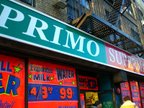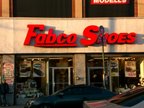Flatbush CommerceFrom The Peopling of New York City
Commerce/ EconomySpending Money in Flatbush
There are many individually owned stores as well as a number of large franchises in Flatbush. As mentioned under Culture, there are many small food shops, like bakeries, that sell ethnic foods. The small stores are specific to the makeup of the community, their needs, and their skills. An example of this is the many hair braiding and weaving shops. From Mickaela Styles-Dominican Hair Shop to Ynosencia Beauty Salon to Woodbine II-Dominican Hair Salon, it is plain to see that the small shops are catering to the demand for Hispanic and African American hair care. Flatbush Avenue especially is bustling with retail. There are Apparel stores, like Cookies, a clothing store, Fabco shoes, and VIM, a shoe store. There are small grocery shops, like Primo Supermarket, and better-known stores for groceries, like the large Super Stop and Shop on Flatbush Avenue and Tilden Avenue. There is a large Modell’s on Church Avenue where the Kenmore Theatre once stood. Other retail stores in the neighborhood include video rental stores, wine and spirits shops, beauty supply stores (again, aimed specifically at African American and Hispanic Hair care), pharmacies and religious stores. The median household income in Flatbush as of 1999 was $37,341. The median family income was at $43,776. The per capita income was at $16,026. Males working full time earning a median of $31,497, and females working full time earning a median of $29,245. Making Money in FlatbushIn Flatbush 61.4% of the population (16 years of age and older) is part of the civilian labor force. Of these, 53.8% are employed, while the other 7.2% are unemployed. The remaining 38.6% were not considered by the census to be a part of the civilian labor force. More then half the working population of Flatbush (60.6%) utilizes public transportation to get them to and from work every day, while 23.6% drive alone, and 9.1% carpooled. Of this population 28% have classified themselves as working in a service population, 27.6% worked in management, professional, or related occupations, and 26.9% worked in sales and office occupations. 9.2% worked in production, transportation, and material moving, and the last 8.2% worked in construction and maintenance. The majority of workers in this neighborhood are private wage and salary workers (73.5%). While the rest are for the most part government employees (23.1%). When the workforce of Flatbush was broken down by industry in the 2000 New York Census, the largest industry in district 40 was educational, health, and social services (at 36%). The next largest industry (at 10.2%) is finance, insurance, real estate, and rental and leasing. The next three are almost neck and neck; professional, scientific, management, administrative, and waste management services (7.8%), retail trade (7.2%), and other services (except public administration) (6.9%). [1] References
|


